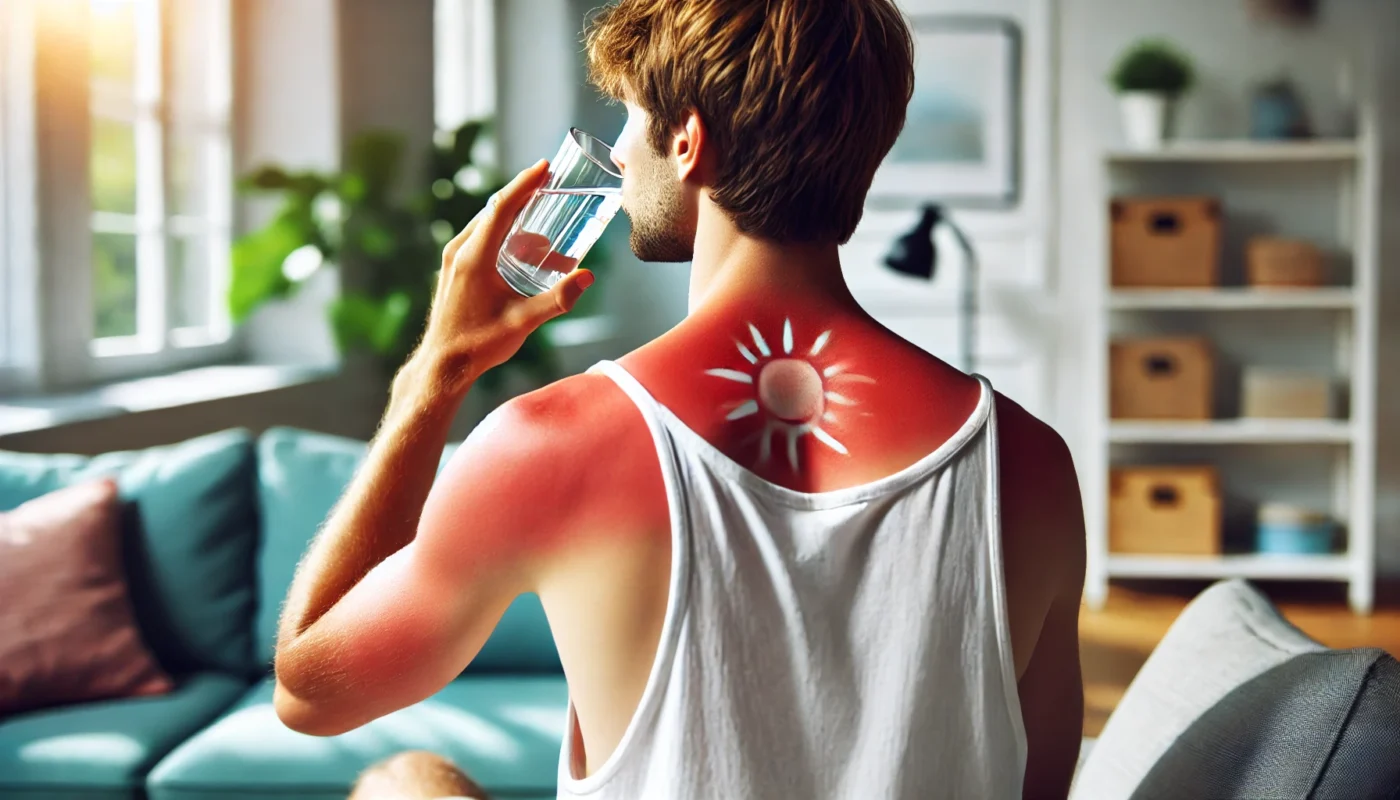Sunburn is an acute inflammatory reaction of the skin induced by overexposure to ultraviolet (UV) radiation from the sun. This condition not only causes pain and discomfort but can also lead to peeling, blistering, and in severe cases, long-term skin damage. Understanding how to effectively manage sunburn is crucial for both immediate relief and long-term skin health.
You may also like: Essential Tips for Sun Protection Daily
The Mechanism of Sunburn
UV Radiation and Skin Damage
Ultraviolet (UV) radiation from the sun is a major contributor to skin damage. It penetrates the skin layers, causing cellular damage that manifests as sunburn. The UV spectrum consists of UVA, UVB, and UVC rays, with UVB being primarily responsible for sunburn. UVA, however, also plays a significant role in skin aging and long-term damage.
The Body’s Defense Mechanism
When the skin is exposed to excessive UV radiation, the body triggers an inflammatory response. This is a natural defense mechanism aimed at repairing the damaged cells. Blood vessels in the affected area dilate, increasing blood flow to facilitate healing, which results in the characteristic redness and warmth of sunburn.
Symptoms and Severity Levels
Initial symptoms of sunburn include redness, tenderness, and warmth in the affected area. As the condition progresses, more severe cases may develop blisters and significant pain. The severity of sunburn can vary, with mild cases causing temporary discomfort and severe cases leading to long-term damage such as skin cancer.
The Long-term Effects of Sunburn
Skin Aging and Damage
Repeated sunburns accelerate the skin’s aging process, leading to wrinkles, loss of elasticity, and pigmentation changes. Chronic exposure to UV radiation can cause DNA damage in skin cells, increasing the risk of skin cancers, including melanoma.
Risk of Skin Cancer
Sunburn significantly raises the risk of developing skin cancer. Each sunburn episode damages the DNA in skin cells, and over time, these damages accumulate, potentially leading to cancerous changes. Protective measures are essential to mitigate this risk.
Psychological Impact
Beyond the physical effects, sunburn can also have psychological impacts. It can affect one’s self-esteem and body image, especially if it leads to visible damage or scarring. Awareness and education about sun protection can help reduce these psychological burdens.
The Role of Pain Relievers in Sunburn Treatment
Pain relievers can be an integral part of managing sunburn pain. They work by reducing inflammation and alleviating discomfort. However, not all pain relievers are created equal, especially when it comes to treating sunburn.
Understanding Pain Relievers
Mechanism of Action
Pain relievers work by targeting different pathways involved in the sensation of pain and inflammation. Some act primarily within the central nervous system, while others target peripheral inflammation, offering varied benefits depending on the type of pain experienced.
Types of Pain Relievers
There are several types of pain relievers, including acetaminophen, non-steroidal anti-inflammatory drugs (NSAIDs), and opioids. For sunburn, NSAIDs and acetaminophen are commonly recommended due to their effectiveness in managing mild to moderate pain.
Choosing the Right Pain Reliever
Choosing the right pain reliever depends on the individual’s medical history, age, and the severity of the sunburn. It’s essential to consult a healthcare professional to determine the most appropriate and safe option.

Tylenol (Acetaminophen) for Sunburn Relief
How Tylenol Works
Tylenol, or acetaminophen, is a commonly used analgesic that can provide relief from sunburn pain. Its mechanism of action is primarily through the central nervous system, where it blocks the production of prostaglandins, compounds that are involved in pain and fever. This makes it effective for reducing discomfort and lowering fever associated with sunburn.
Limitations of Tylenol
While Tylenol is effective in reducing pain and fever, it does not possess anti-inflammatory properties. Therefore, while it can help with the discomfort associated with sunburn, it may not be as effective in reducing the underlying inflammation compared to other medications. Individuals seeking relief from inflammation might need to consider alternatives.
Safety and Dosage Considerations
Tylenol is generally considered safe when used as directed. However, it is crucial to adhere to recommended dosages to prevent potential liver damage. Individuals with liver conditions or those consuming alcohol regularly should exercise caution and seek medical advice before use.
Ibuprofen and Aspirin: Alternatives to Consider
Benefits of NSAIDs
When considering alternatives to Tylenol, ibuprofen and aspirin are often mentioned due to their anti-inflammatory effects. Both belong to a class of medications known as non-steroidal anti-inflammatory drugs (NSAIDs), which offer dual benefits of pain relief and inflammation reduction.
Ibuprofen for Sunburn Relief
Ibuprofen, known by brand names such as Advil and Motrin, not only alleviates pain but also reduces inflammation, making it a potentially more comprehensive option for sunburn relief. Its effectiveness in reducing swelling and redness can be particularly beneficial for severe sunburn cases.
Aspirin’s Role and Precautions
Aspirin, also an NSAID, can help to reduce inflammation and pain. However, it is not recommended for children or teenagers with viral infections due to the risk of Reye’s syndrome, a rare but serious condition. Adults can benefit from its anti-inflammatory properties, but should be aware of potential gastrointestinal side effects.
Choosing the Right Pain Reliever
When deciding between Tylenol, ibuprofen, or aspirin for sunburn relief, consider the following:
Severity of Inflammation
If inflammation is pronounced, an NSAID like ibuprofen might offer more comprehensive relief. These medications can effectively reduce swelling and redness, making them suitable for more severe cases of sunburn.
Medical History and Interactions
Individuals with certain medical conditions or those taking specific medications should consult a healthcare professional to avoid potential interactions. NSAIDs, for example, can interact with blood thinners or exacerbate certain medical conditions like hypertension.

Age and Health Status
Aspirin should be avoided in certain populations, such as children and teenagers with viral illnesses, due to the risk of Reye’s syndrome. Elderly individuals or those with existing health conditions should also seek medical advice before using NSAIDs.
Additional Sunburn Management Strategies
While pain relievers can provide symptomatic relief, comprehensive sunburn management should include other strategies to support healing and prevent further damage.
Topical Treatments
Aloe Vera’s Healing Properties
Aloe Vera is renowned for its soothing and healing properties. Applying aloe vera gel to sunburned skin can provide immediate cooling relief and promote healing by reducing inflammation and moisturizing the skin. Its natural compounds aid in skin repair and hydration.
Importance of Moisturizers
Keeping the skin hydrated is essential for recovery. Use a gentle, fragrance-free moisturizer to lock in moisture and prevent further irritation. This helps maintain the skin’s barrier function, promoting faster healing and reducing the risk of peeling.
Over-the-Counter Creams
Various over-the-counter creams containing hydrocortisone or other soothing agents can help alleviate itching and inflammation. These topical treatments can be particularly useful for managing the discomfort associated with more severe sunburns.
Hydration and Nutrition
The Role of Hydration
Sunburn can lead to dehydration, as the body loses fluids through damaged skin. It is important to increase fluid intake to support skin repair and overall recovery. Staying hydrated helps maintain skin elasticity and promotes healing.
Nutritional Support for Skin Recovery
A diet rich in antioxidants, such as fruits and vegetables, can aid in skin recovery by reducing oxidative stress. Vitamins like C and E play a crucial role in repairing skin damage and supporting the immune system in its healing efforts.
Supplements and Natural Remedies
Certain supplements, such as omega-3 fatty acids and zinc, can support skin health and recovery. Additionally, natural remedies like green tea or chamomile can provide anti-inflammatory benefits when consumed or applied topically.
Prevention and Protection
Effective Use of Sunscreen
Regular application of a broad-spectrum sunscreen with at least SPF 30 can prevent future sunburns. It’s important to apply sunscreen 20 minutes before sun exposure and reapply every two hours, especially after swimming or sweating.
Protective Clothing and Accessories
Wearing hats, sunglasses, and long-sleeved clothing can further shield the skin from harmful UV rays. These protective measures are especially important during peak sun hours when UV radiation is strongest.
Educating on Sun Safety
Raising awareness about sun safety and the importance of protective measures can significantly reduce the risk of sunburn. Educational programs and public health initiatives can play a key role in promoting sun-safe behaviors.

Conclusion: Making Informed Choices
In conclusion, while Tylenol can be effective in managing the pain associated with sunburn, it lacks anti-inflammatory properties. Alternatives like ibuprofen or aspirin may offer more comprehensive relief due to their ability to reduce inflammation. However, the choice of pain reliever should be guided by individual health considerations and medical advice.
Ultimately, a holistic approach that combines appropriate pain management, topical treatments, hydration, nutrition, and preventive measures will best support skin health and recovery from sunburn. Remember, the best treatment for sunburn is prevention. Regular use of sunscreen and protective clothing remains the most effective strategy to protect your skin from the harmful effects of UV radiation.
Further Reading:
What to do if … you get a bad sunburn
7 Sunburn Relief Tips (and How To Prevent It Next Time)
Sunburn relief: Managing symptoms
tylenol, sunburn relief, pain management, acetaminophen, ibuprofen, aspirin, NSAIDs, skin health, UV radiation, sun safety, topical treatments, hydration, skin recovery, sunburn treatment, skin damage, prevention.
Important Note: The information contained in this article is for general informational purposes only, and should not be construed as health or medical advice, nor is it intended to diagnose, prevent, treat, or cure any disease or health condition. Before embarking on any diet, fitness regimen, or program of nutritional supplementation, it is advisable to consult your healthcare professional in order to determine its safety and probable efficacy in terms of your individual state of health.
Regarding Nutritional Supplements Or Other Non-Prescription Health Products: If any nutritional supplements or other non-prescription health products are mentioned in the foregoing article, any claims or statements made about them have not been evaluated by the U.S. Food and Drug Administration, and such nutritional supplements or other health products are not intended to diagnose, treat, cure, or prevent any disease.

